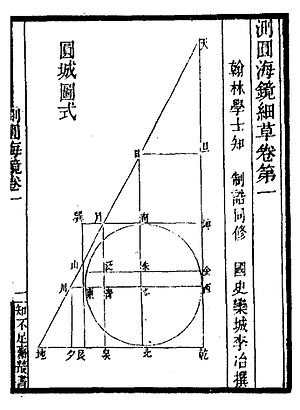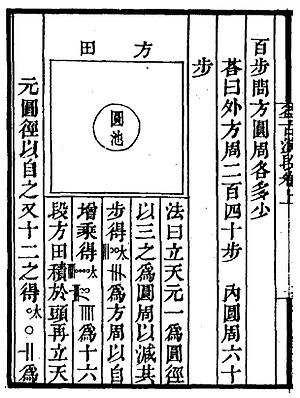- Li Zhi (mathematician)
-
Li Zhi (Chinese: 李治) (1192–1279), later Li Ye (李冶), was a Chinese mathematician and scholar, who published and improved the tian yuan shu method for solving polynomial equations of one variable.[1][2][3][4][5][6]
Contents
Name
He was born Li Zhi, but later changed his name to Li Ye to avoid confusion with the third T'ang emperor who was also named Li Zhi, removing one stroke from his original name to change the character. His name is also sometimes written as Li Chih or Li Yeh. The literary name was 仁卿 (Renqing, Jen-ch’ing) and appellation was 敬斋 (Jingzhai, Ching-chai).
Life
Li Zhi was born in Ta-hsing (now Beijing). His father was a secretary to an officer in the Jurchen army. Li passed the civil service examination in 1230 at the age of 38, and was administrative prefect of Jun prefecture in Henan province until the Mongol invasion in 1233. He then lived in poverty in the mountainous Shanxi province. In 1248 he finished his most known work Ceyuan haijing (測圓海鏡, Sea mirror of circle measurements). Li then returned to Hebei.
In 1257 Kublai Khan, grandson of Genghis Khan, sent for Li to get advice on government and science. In 1259 Li completed Yigu yanduan (益古演段, New steps in computation), also an important mathematics text. After becoming Khan, Kublai twice offered Li government positions. He politely declined, referring to his age and ill health. In 1264 Li finally accepted a position at the Hanlin Academy, writing official histories. He was critical of the politics and resigned after a few months, again citing ill health.[2] He spent his final years teaching at his home near Feng Lung mountain in Yuan, Hebei. Li told his son to burn all of his books except for Sea mirror of circle measurements. Fortunately other texts, both mathematical and literary, still survived.
Work in mathematics
Ceyuan haijing
Ceyuan haijing (Sea mirror of circle measurements) is a collection of 170 problems, all related to the same example of a circular city wall inscribed in a right triangle and a square. They often involve two people who walk on straight lines until they can see each other, meet or reach a tree in a certain spot. It is not a geometry book, the purpose of the geometrical problems are to create algebraic problems.
Many of the problems are solved by polynomial equations, which are represented using a method called tian yuan shu, "coefficient array method" or literally "method of the celestial unknown". Li Zhi is the earliest known source of this method, though it was known before him in some form. It is a positional system of rod numerals to represent polynomial equations.
For example 2x2 + 18x − 316 = 0 is represented as
 which in Arabic numerals is
which in Arabic numerals is 
The 元 (yuan) denotes the unknown x, so the numerals on that line mean 18x. The line below is the constant term (-316) and the line above is the coefficient of the quadratic (x2) term. The system accommodates arbitrarily high exponents of the unknown by adding more lines on top and negative exponents by adding lines below the constant term. Decimals can also be represented. Later, the line order was reversed so that the first line is the lowest exponent.
Li does not explain how to solve equations in general, but shows it with the example problems. Most of the equations can be reduced to the second or sometimes third order. It is often assumed that he used methods similar to Ruffini's rule and Horner scheme.
Yigu yanduan
Main article: Yigu yanduanYigu yanduan (New steps in computation) is a work of more basic mathematics written soon after Li Zhi completed Ceyuan haijing, and was probably written to help students who could not understand Sea mirror of circle measurements. Yigu yanduan consists of three volumes dedicated to solving geometrical problems on two tracks, through Tian yuan shu and geometry.
See also
References
- ^ O'Connor, John J.; Robertson, Edmund F. (December 2003). "Li Zhi Biography". MacTutor History of Mathematics archive. University of St Andrews in Scotland. http://www-history.mcs.st-and.ac.uk/Biographies/Li_Zhi.html. Retrieved 21 December 2009.
- ^ a b Breard, Andrea (2009). "Li Ye". Encyclopædia Britannica Online. http://www.britannica.com/EBchecked/topic/338734/Li-Ye. Retrieved 2009-12-20.
- ^ Ho, Peng Yoke (2000). Li, Qi and Shu: An Introduction to Science and Civilization in China (unabridged ed.). Courier Dover Publications. pp. 89–96. ISBN 0486414450. http://books.google.com/books?id=_P6C4JO4JCUC&pg=PA89. Retrieved 2009-12-21.
- ^ Ho, Peng Yoke (2008). "Li Chih, also called Li Yeh". Complete Dictionary of Scientific Biography. Charles Scribner's Sons. http://www.encyclopedia.com/doc/1G2-2830902611.html. Retrieved 2009-12-21. Via encyclopedia.com.
- ^ Lam Lay-Yong; Ang Tian-Se (September 1984). "Li Ye and his Yi Gu Yan Duan (old mathematics in expanded sections)". Archive for History of Exact Sciences (Berlin / Heidelberg: Springer) 29 (3): 237–266. doi:10.1007/BF00348622.
- ^ Swetz, Frank (1996). "Enigmas of Chinese Mathematics". In Ronald Calinger. Vita mathematica: historical research and integration with teaching. MAA Notes. 40. Cambridge University Press. pp. 89–90. ISBN 0883850974. http://books.google.com/books?id=D21wKHoYGg0C&pg=PA89. Retrieved 2009-12-20.
Categories:- Chinese mathematicians
- 13th-century mathematicians
- Yuan Dynasty people
- People from Shijiazhuang
- 1192 births
- 1279 deaths
Wikimedia Foundation. 2010.


